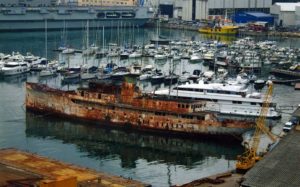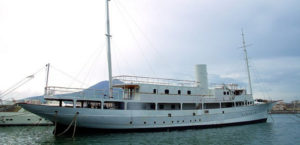Most new build yachts are based on a specific order and reflect exactly the intentions of the owners. The designers and companies taking care of the engineering have applied the best available technology to make everything fit perfectly together.
In the case of a conversion, rebuild or refit, the end result can be disappointing. This article reviews some critical steps that can go wrong.
1. The perfect ship.
Looking at a ship, one wonders if something nice could be done with it. Then someone has a vision. This could be the perfect… (expedition yacht, party boat, support yacht for my sailing schooner…). Way too often, the project is started, meaning the vessel bought, at this stage of the reflection.
Some details are already important, such as access to the water and storage of toys. We have seen ghastly stern platforms added on very nice looking classic hulls, totally nonfunctional drop down platforms, stern or side, but also hull rebuilds that add to the beauty of a ship while giving the added access and storage spaces.
Maneuvering and parking in modern crowded marinas also impose some thought on feasibility, addition of thrusters and simply draught constraints. All this can be reflected upon while looking at a vessel alongside an odd lay berth
In an ideal world, there is a more defined project before the actual purchasing takes place. It outlines the number of guests or owner’s party, the spaces they will need and the services they will require.
(Former presidential yacht Williamsburg. She finally sank and was scrapped)
2. the project.
The project will define the flag to use, statutory status of the ship and classification society most suited. There is no ideal solution between a purely private yacht and a full-fledged passenger ship. What you can gain in tax flexibility and number of guests will be lost in ease of operation and freedom of anchorage, pilot restrictions and ISPS considerations.
The project will consider the navigation areas, meaning weather, sea states and range. The type of operations has bearing on the choice of tenders and toys, but also their handling. We have seen some serious failings on ships with beautiful tenders that could not be launched in any swell. Expedition experts will also tell you that fast launching and access to light and flexible boats is critical to not miss sightings and photo opportunities.
Does the project include a submarine, helicopter, range of jet skis and wave runners, wheeled tenders and landing barges for the cars and bikes? What about interior creature comfort? We may want a cinema, spa area, massage rooms, sauna and Turkish bath, professional gym, in and out swimming pool converting into a disco…
(Yacht refit project ROSSY ONE, from YachtCharterFleet.com)
3. The budget.
When the project is defined, it is still a dream. Putting figures onto it makes it more real. So to the question of “how much will this cost?” I would tend to reply “What everybody told you times three”. The brutal truth is that, quite often, a prospective owner gets an idea of the costs from his agents, the seller, consultants or other interested parties. Can he afford just that at a stretch, or is he happy with the possibility that the budget will treble and so will the delays? If not, go for new, or go for smaller.
It is almost impossible to factor everything in advance, and we have been involved in projects where most of the existing structure had to be scrapped to adapt to current regulations. I know of a yacht that had two successive rebuilt of her stern: one to give access to water, the next one because the first one had made her too heavy for load line regulations. There is at least one refit project on sale today with portholes so low that they will all have to be welded shut for classification, meaning loss of accommodation space.
Thinking about the budget we shall also have to consider the next step, which in my view is the most important one and must be looked into as early as possible: the operation model.
(Just a few months before, this was a “ready to use” space… think again)
4. The Model.
Assuming we know everything about the rules, type of ship, operation area etc… we still need to define the way it will happen. This regards, crew, size, appointment of spaces and so on.
The crew for instance: We know of two yachts of similar lengths, say around 80m for 12 guests, both private. One has 45 relatively cheap crew guaranteeing full time staffing of all service spaces. They are generally happy but live in conditions close to the minimum acceptable under the MLC. Chances are that they have high rotation rate and are not extremely motivated or mentored. The other has 16 crew, all in individual cabins and with great salary and social packages. The owner gets top notch service at all times as none of the crew wants to face discharge. Basically, you must kill someone to get on that yacht.
The nationality of crew will affect the mood on board, costs of flying the crew home and back, accessibility for the yacht to some countries. If you want to go fully commercial, do you wish a variety of languages available. Also a wealth of non marine related talents, such as musicians and great party organisers among the troops.
The same goes to space allocation. Do you fancy reducing the size of guest suites to allow the cinema or gym to be larger? Do you want provision space for six month, paint for the next refit and spare lubes in case something wrong happens? Even at the original refit design stage, the mode of propulsion will define the necessary space, particularly now with hybrid and electric propulsion and pods.
Do you have access to a various local work force to make things happen? We were once required to man all four bars at all times when guests were awake. That is four crew when the service team is only three strong. A ship with fixed navigation areas or working in collaboration with an expedition agent will be able to delegate some work to local people, which also allows saving office space and equipment on board and avoid losing a staff member to be the concierge and cruise director.
(When the dream has become a viable reality)
5. Conclusion.
Like with new building, a conversion or refit starts with design. If someone falls in love with a boat and just wants to make something out of it, then the program and model must still be realistic and tailored to the optimal possible use of the finished product. On the other hand, if the project goes before the ship, then the market should be observed extensively until the perfect base is discovered.
We at MaST, have a team that has been working very long in boating, commercial shipping and the last few years in luxury yachting. We were fortunate to work with ships of many sizes and different designs, so we can appreciate what works and what does not.
Most of all, we love to talk about boats and ships, so never hesitate to drop us a line.





